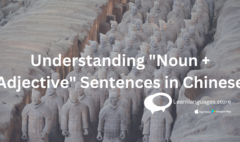The “shi… de” Construction for Emphasizing Details
The “shi… de” Construction for Emphasizing Details
Estimated reading time: 3 minutes

Introduction:
The “shi… de” construction is a versatile tool in Mandarin Chinese used for emphasizing specific details in a sentence. It’s particularly handy when discussing past events or asking questions about past occurrences.
When to Use It:
This construction is ideal for drawing attention to particular details in a sentence, especially when discussing past events. Instead of relying solely on the past tense marker “le,” “shi… de” helps to specify and emphasize certain aspects of the past situation.
Affirmative Form:
Structure: Subject + 是 + [Detail to be Emphasized] + Verb + 的
Example Sentences:
- A: 你们 是 什么 时候 到 的?
(Nǐmen shì shénme shíhou dào de?)
When did you guys arrive?
B: 我们 是 昨天 到 的。
(Wǒmen shì zuótiān dào de.)
We arrived yesterday. - A: 你 是 在 哪儿 出生 的?
(Nǐ shì zài nǎr chūshēng de?)
Where were you born?
B: 我 是 在 香港 出生 的。
(Wǒ shì zài Xiānggǎng chūshēng de.)
I was born in Hong Kong. - A: 谁 告诉 你 的?
(Shéi gàosu nǐ de?)
Who told you?
B: 一 个 同事 告诉 我 的。
(Yī gè tóngshì gàosu wǒ de.)
A colleague told me.
Negative Form:
Negating a “shi… de” construction requires the use of 不 before 是.
Example Sentences:
- 他们 不是 在 网上 认识 的。
(Tāmen bù shì zài wǎngshàng rènshi de.)
Translation: They didn’t meet online. - 他 不是 跟 我们 一起 去 的。
(Tā bù shì gēn wǒmen yīqǐ qù de.)
Translation: He didn’t go with us.
Used in a Question:
“Shi… de” constructions can be formed into questions using various question structures in Chinese.
Example Sentences:
- 她 用 邮件 回复 的 吗?
(Tā yòng yóujiàn huífù de ma?)
Translation: Did she reply by email? - 你们 是 不 是 去年 认识 的?
(Nǐmen shì bu shì qùnián rènshi de?)
Translation: Did you meet each other last year?
Exception:
While “shi” is typically optional in this construction, omitting it can sometimes lead to ambiguity regarding the emphasized detail in the sentence. It’s generally safer to include “shi” for clarity, especially in more complex sentences.
Conclusion:
The “shi… de” construction is a powerful tool in Mandarin Chinese for emphasizing specific details in a sentence, particularly when discussing past events or asking questions about past occurrences. Mastering this construction adds depth and clarity to your communication in Chinese.
Learn Languages Store
Vashi,
Email: services@learnlanguages.store










